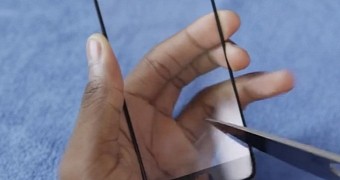There are few smartphones that employ the use of sapphire displays and most of them do so for marketing reasons. Kyocera Brigadier and Huawei Ascend P7 are among the latest devices with such tough displays, but Apple is rumored to include the technology in its iPhone 6 as well.
However, there’s a lot of debate going on regarding the actual toughness of the sapphire displays over those protected by Corning Gorilla Glass.
Even though sapphire glass is four times tougher than Corning Gorilla Glass and much more transparent than any other protective glass, the weak point for sapphire is the fact that it’s prone to shatter even when dropped from short distances.
Another disadvantage would be the fact that it’s much heavier than the Corning Gorilla Glass and costs 3 or 4 times more. But while these two downsides can be solved more or less easily, the fact that sapphire displays can get shattered too easily to even be worth taken into consideration for use inside every smartphone is what’s more important.
Since Apple was rumored to plan on including sapphire displays in its future products, there have been lots of live tests done that proved that the Cupertino company would make a big mistake if the iPhone 6 were packed with such a screen.
However, it appears that Apple may have found the winning formula regarding the polishing and cutting of sapphire, so that it can be safely used inside its products.
Both iPhone 6 models are now rumored to sport sapphire displays, which would make them indestructible. For your information, sapphire is the toughest material that can be used for display protection, only second to diamond on the hardness scale.
The main reason for which sapphire glass is so prone to shatter is the flawed processing of the material, thus making it more prone to easily break when dropped.
Sapphire glass is four times harder than Corning Gorilla Glass
Because of the way the sapphire glass is cut and polished, defects may inadvertently be introduced in the material, which is why the displays often shatter very easily.
Even the slightest flaw or scratch in the sapphire glass can make the display burst into pieces when dropped from 2 or 3 feet (60 - 90 cm). But there are ways to fix this issue, which Apple seems to have already found considering that the company has decided to put this kind of display into its iPhone 6.
First of all, Apple may have found a way to process sapphire glass to eliminate any possible flaw in the material. Secondly, the iPhone 6 needs to have a design that can absorb the energy of an impact and dissipate it in such a way that the sapphire display would not shatter.
The iPhone 6’s metallic edges will be essential in protecting the sapphire display, which is a brittle glass per se and can break no matter what technologies you employ.
Now, the latest leaks coming directly from China claim the iPhone 6 will be “shatter proof,” which means Apple has found a way to make sapphire displays viable for smartphones. It remains to be seen if the rumors are true and to what degree the iPhone 6’s sapphire display is indestructible.

 14 DAY TRIAL //
14 DAY TRIAL //